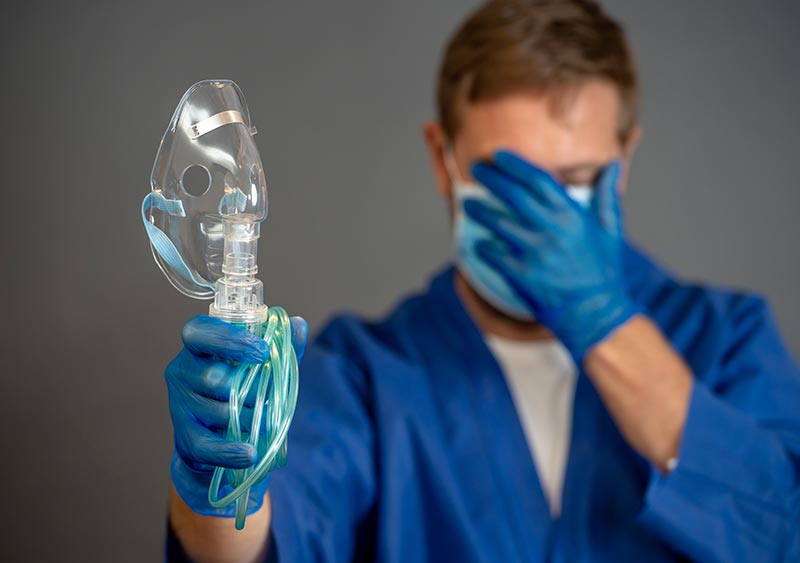Elite Medical Experts
TUCSON—On June 30, 2021, the U.S. Food and Drug Administration (FDA) alerted the public about a voluntary recall of specific Philips Respironics ventilators, BiPAP, and CPAP devices due to the risk of exposing users to particulate matter and off-gassing from polyester-based polyurethane (PE-PUR). FDA warned that degraded PE-PUR, a component of the foam used to dampen noise and vibration, may inadvertently enter the device’s airflow pathway where it can be inhaled or ingested during therapeutic use of the machine. The recall notice followed Philips’ April 2021 announcement that they had internally “identified a quality issue in a component that is used in certain sleep and respiratory care products.”
Polyurethanes are chemically inert organic molecules for which no exposure limits have been set by the Occupational Safety and Health Administration (OSHA). The two most common types — polyether polyurethane and polyester polyurethane —- are found in countless clinical, industrial, scientific, and retail domains. Polyester polyurethane is used in applications ranging from commercial rolling equipment to sound dampening foam. In certain Philips respiratory devices, including market-leading Trilogy and DreamStation product lines, polyester polyurethane foam was used to reduce noise and provide a better user experience. The physical properties of polyester polyurethane allow for degradation into fine particles, a process which may be exacerbated by commercially available but otherwise unapproved cleaning methods including ozone gas and ultraviolet light. Degradation may also result from microbial agents, heat, and humidity. In addition to exposing users to physical particles of debris, degraded PE-PUR can also release noxious chemicals which users unknowingly inhale from affected devices.
While FDA is unaware of any deaths related to particulate exposure or off-gassing from affected devices, they explicitly warned that “(t)hese issues can result in serious injury, which can be life-threatening, cause permanent impairment, and require medical intervention to prevent permanent damage.” FDA further noted that the potential risks of particulate exposure and/or off-gassing include irritation to the skin, eyes, and respiratory tract, inflammatory responses, headache, asthma, nausea, vomiting, and toxic or carcinogenic effects on the kidneys and liver. Philips received several consumer complaints regarding the presence of black debris in some of their devices, and also received reports of headache, upper airway irritation, cough, chest pressure, and sinus infections. While the presence of particulate debris and the occurrence of symptoms may be causally linked, their relationship has not been scientifically proven.
“Direct exposure to foam particulates and chemicals can be dangerous for several reasons,” said Dr. Venktesh Ramnath, an Associate Clinical Professor of Pulmonary Medicine at UC San Diego Health. “Inhalation of particulate foam can lead to difficulty breathing and frank respiratory failure, and bacteria or fungus carried into the body can cause infection in the respiratory tract and lungs.” Regarding off-gassing, Dr. Ramnath added, “inhalation of isocyanates and other gases associated with polyurethane can cause lung irritation, and some may be carcinogenic in their own right. Prolonged exposure to these chemicals is worrisome, particularly since many people using CPAP and BiPAP already have underlying asthma and other respiratory diseases.”
Despite the adverse health effects associated with particles and gases from polyurethane foam, it may be difficult to establish causation since many of the symptoms specified in the recall are common in the general population and may have plausible alternative explanations. “Merely identifying the presence of symptoms, even if they are on the list provided by Philips, does not establish a causative link with the potential exposure,” says Dr. Tom Fariss, recent Vice President of Global Health at Kimberly Clark Corporation and a Board-Certified specialist in Internal Medicine and Occupational Medicine. “Confounding factors associated with both an exposure and a health outcome will muddy causation. For example, headache is a symptom mentioned in the recall, but people with sleep apnea are already prone to headaches, and people with sleep apnea also use CPAP machines. That makes sleep apnea a classic confounding factor.” While this example highlights the difficulty of establishing causation in the absence of epidemiologic data, Dr. Fariss believes that cancer causation may be even more difficult to prove since “the epidemiology is underdeveloped for this type of exposure, and typical latencies for cancer are measured in years or decades.”
“The complex issues in this recall will necessitate expert witnesses from a variety of disciplines,” says Dr. Burton Bentley II, an Emergency Medicine specialist and CEO of Elite Medical Experts. “We anticipate the need for experts in Pulmonology, Toxicology, Epidemiology, Biomedical Device Engineering, and Polymer Science. Physician experts in Occupational & Environmental Medicine will also have a role since they are frequently involved in human exposure to toxic compounds.” Regardless of the trajectory of litigation, Dr. Bentley added, “the most important thing right now is to focus on the health and safety of the millions of people affected by the recall. That means seeing a doctor and assuring that you have a safe device.”
About Elite Medical Experts: Elite is a frontline resource for legal teams, insurers, corporations, and governmental entities in need of strategic insight at the intersections of Medicine, Business, and Law. Elite also aligns nationally recognized Professors of Medicine and Surgery as subject matter consultants and expert witnesses. With over 8000 engagements totaling nearly $3 billion at risk, Elite solves challenges so that clients win.

